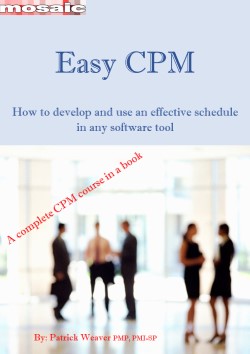Location:
PMKI > IT
& Construction Industries > Claims
and Forensic Analysis.


- Forensic analysis and reporting
- Assessing Delay and
Disruption
- Concurrent and
Parallel Delays
- Referenced Court
Judgements
- Casewatch Publications
- Claims & Expert Witness
- Useful External Web-links &
Resources.
Other related sections of the PMKI:
- Contractual Dispute
Management
- Mosaic's Dispute Management and
Support Services
- Project Controls &
Scheduling
 Aspects
of project management that are primarily focused on
understanding the causes of project issues and problems
and/or developing and assessing the implication of issues
or problems.
Aspects
of project management that are primarily focused on
understanding the causes of project issues and problems
and/or developing and assessing the implication of issues
or problems.
Forensic analysis is usually carried out by an independent expert who has been commissioned to prepare a report either for use by the organizations management, or more often for use in litigation. Developing an 'expert' report to defend, or prosecute, a claim requires a very disciplined approach: It is a capital mistake to theorize before one has data. Insensibly one begins to twist facts to suit theories, instead of theories to suit facts (Sir Arthur Conan Doyle). A good 'expert report' is based on researched and validated data, with the determined facts (supported by the data) clearly separated from expert opinion derived from the facts. After many years of practice, we are getting quite good at this.
Mosaic provides expert assistance in the preparation and defense of claims. See more on our Dispute Management and Support Services page.
Forensic analysis should be seen as part of an overall dispute management strategy, rather than as an end in itself. See more on Contractual Dispute Management page.
Delay claims, linked to disruption and acceleration cost claims are common in the construction and engineering industries and are becoming more common in other projects. A key area of each claim, present in most contractual disputes, involves assertions of delay with associated disruption and/or acceleration costs. This type of claim usually appears after normal contract processes are being severely tested and the contractor has engaged experts to assist its cause. This section is designed to help both industry decision makers, and ADR and legal professionals, understand the options available to disputants in assessing ‘delay’ to help them quickly cut through the fog of expertise present in many major disputes to achieve a speedy determination.
The basis of assessment in most of AACEI and SCL
approaches discussed below, and by far the easiest frame
to use in presenting or defending a claim is a competently
developed and maintained critical path (CPM) schedule.
However, the increasing number of agile projects and the
need for agility to manage distributed projects means
there is an emerging need for assessment processes that
are not dependent on a CPM schedule, these are covered in
Assessing Delays in Agile & Distributed Projects.
 Easy CPM is
a course-in-a-book that provides practical training and
guidance to individuals and organizations involved in
developing or using CPM schedules based on the Critical
Path Method (CPM). It is designed to act as both a
reference, and practice guide, for people implementing CPM
scheduling after they have learned to use the CPM
scheduling software of their choice.
Easy CPM is
a course-in-a-book that provides practical training and
guidance to individuals and organizations involved in
developing or using CPM schedules based on the Critical
Path Method (CPM). It is designed to act as both a
reference, and practice guide, for people implementing CPM
scheduling after they have learned to use the CPM
scheduling software of their choice.
PP: Assessing Delay
and Disruption - Tribunals Beware. This paper
is based on the AACE® International Recommended
Practice No. 29R-03 Forensic Schedule
Analysis it:
- Describes the origins, strengths and weaknesses of
‘Critical Path’ scheduling.
- Outlines the current ‘state of play’ with regards to the
practice of scheduling.
- Describes the primary approaches to delay analysis,
their strengths and weaknesses, including:
- As-Built v As-Planned
- Impacted As-Planned
- Collapsed As-Built
- Window Analysis and its variant, Time
Impact Analysis.
- Describes the type of record needed to support the delay
analysis.
It concludes by suggesting some questions a tribunal (or
manager) may choose to direct to various scheduling
experts appearing before them to ascertain the robustness
of the evidence being presented to help turn the mass of
data typically accumulated in a ‘claim’ into information.
The complexities around concurrent and parallel delays are
discussed.
PP:
Assessing Delay – the SCL Options. This paper
reviews The Society of Construction Law Delay and
Disruption Protocol (2nd edition), and
contrasts the SCL Protocol with the AACE®
International Recommended Practice No. 29R-03 Forensic
Schedule Analysis (2011 Ed.). Both documents
take a very similar approach to assessing delay and
disruption on construction projects. The fundamental
difference is in the focus of the documents, the objective
SCL Protocol is to provide useful guidance on some of the
common delay and disruption issues that arise on
construction projects, with a view to minimizing disputes
whereas AACEi 29R-03 focuses on forensically analyzing
delays after the dispute has arisen.
Download the original PMWJ version of
this paper.
Download the Delay and Disruption Protocol - free
of charge from The Society of Construction Law (UK): https://www.scl.org.uk/
PP: Delay, Disruption and Acceleration Costs. Unfortunately, most prolongation or disruption claims seem to result in excessively large cost claims that damage any possibility of negotiating a reasonable settlement. This paper examines the theoretical underpinnings of ‘delay and disruption’ costs to suggest a realistic basis for their calculation. It is designed to help non-experts see through the ‘smoke and mirrors’ of schedule claims to understand what’s likely to be real, what’s feasible and what’s hyperbole.
PP:
Assessing Delays in Agile & Distributed
Projects. This paper offers a practical
solution to the challenge of assessing delay and
disruption in agile and distributed projects
where the traditional concept of a ‘critical path’ simply
does not exist and the effect of intervening events has to
be considered in terms of loss of resource efficiency. The
internationally recognized approaches to assessing delay
and disruption discussed in the papers above, are based on
the premise there is a well-developed critical path (CPM)
schedule that defines the way the work of the project will
be accomplished allowing the effect of events that delay
or disrupt activities to be modeled and responsibility for
the assessed delay assigned to the appropriate
party.
Download the PowerPoint: P215 Assessing Delays In Agile &
Distributed Projects PPT
Download
the original April 2024 PMWJ version of this paper.
Or, view the PC Expo 2024 presentation:
Some of the approaches outlined in RP 29R-03
or the SCL Protocol may be used after the
project is complete if an 'as-built' CPM schedule is
constructed after the event, but, an as-built schedule
does not help with contemporaneous assessments during the
project. Developing and using an 'as-built' CPM schedule
is discussed in: Delay Analysis on Non‐CPM Scheduled
Projects.
Click through to see more on Managing
Agile and Distributed Projects.
Blg:
Costain vs Haswell Revisited. This judgement
has a number of important findings relating to schedule
delay analysis:
1. It is necessary to prove the delay event caused a
delay to completion (a challenge for a Windows approach
to delay assessment).
2. A CPM schedule is unlikely to provide a sound
basis for delay assessment in agile and distributed
projects.
Blg: White Constructions v PBS Holdings Revisited.Confirms the Costain judgement in Australia.
Blg: Commercializing Agile. Choosing to use Agile as a project delivery methodology will not change the laws of contract, which means organizations using the agile methodology will need to become more commercial and adapt their processes. This post looks at some of the issues involved in administering contract claims when agile methodologies are being used to deliver the project output.
Blg: Dealing with client delay. Preventing or minimizing client induced delay is a common issue. Whilst this type of delay can never be completely eliminated, they can be reduced by applying this pragmatic six stage approach.
Blg: Liquidated Damages. In Common Law jurisdictions, liquidated damages are a pre-agreed sum of money stipulated in a contract that one party must pay to the other as compensation for breaching a contractual obligation.This judgement confirms the requirement for the estimate to be a genuine pre-estimate.
 Concurrent and
parallel delays occur when two separate causes of delay
affect the same project during the same, or overlapping,
periods of time. In this situation determining the cause
of the delay and consequently which party is responsible
for the consequences of the delay can be very complex.
Concurrent and
parallel delays occur when two separate causes of delay
affect the same project during the same, or overlapping,
periods of time. In this situation determining the cause
of the delay and consequently which party is responsible
for the consequences of the delay can be very complex.
"Time is money" is an often heard statement that drives and motivates every player engaged in the project management industry. Ironically it is also the dual elements of time and money that cause some of the most time and money consuming disputes, particularly in the construction and engineering industries. One of the most troubled and complicated area is that relating to the concept of concurrent delay, which is a strongly contested topic. Both parties to a construction contract regularly use concurrent delay as an excuse to avoid responsibility for extension of time claims and the assessment of liquidated damages.
To date there has been no uniform application of legal principles to the concept of concurrent delay. This is largely due to the fact that the answer to the concurrent delay dilemma is complicated because it is requires consideration of the interaction of many different factors. The aim of this section is twofold. The first is to identify the variety of principles or methodologies that may be followed in resolving parallel delay disputes. The second is to outline the various practical aspects relating to dealing with concurrent delay disputes, by examining methods of assessing concurrent delays, categories of information that must be sourced in resolving parallel delay disputes and practical contractual management techniques in securing relevant and contemporaneous information to deal with the consequences of parallel delays within a construction contract.
WP: Independent, Serial and Concurrent Delays. An overview of the differences between independent, serial and concurrent delays and the options for assessing the effect of concurrent delays.
Art: Concurrent Delays – UK High Court Decision Supports SCL Protocol. This article discusses an English High Court decision supporting the approach to concurrent delays advocated in the Society of Construction Law Delay and Disruption Protocol and our White Paper (above). This judgement is likely to be influential in the UK, Australia and most Commonwealth countries, requiring expert assessment and analysis to be founded in common sense. The SCL Protocol can be downloaded from: https://www.scl.org.uk/ (free for personal use).
PP: Concurrent Delays in Contracts. The concept of concurrent delay is a strongly contested topic in the building and construction industry. The aim of this paper by Jim Doyle is twofold. The first is to identify the variety of principles or methodologies that may be followed in resolving parallel delays disputes. The second is to outline the various practical aspects relating to dealing with concurrent delays disputes (see the original paper).
Navigant Consulting: a series of papers highlighting the differences in approach to assessing concurrent delays in different regions of the world:
- Navigant
Consulting: Focus on Southeast Asia
- Navigant
Consulting: Comparison of English and U.S. Law
- Navigant
Consulting: Concurrent Delay and the Critical Path, the
AACE Protocol
- Navigant
Consulting: Concurrent Delay (USA).
Delay and Disruption Protocol - The Society of Construction Law (UK): https://www.scl.org.uk/
 UK
and Australian Judgements referenced in this section.
UK
and Australian Judgements referenced in this section. Holme v Guppy (1838)
Confirms the "prevention principle", which states that "if
the party be prevented by the refusal of the other
contracting party from completing the contract within
the time limited he is not liable in law for the default".
See also: Turner Corporation Pty Ltd v Austotel
Pty Ltd (1994)
Turner
Corporation Ltd v Co-ordinated Industries Pty Ltd &
Ors. (1995) and
Peak
Constructions (Liverpool) Ltd v McKinney Foundations Ltd
(1970)
Hadley
& Anor v Baxendale & Ors [1854] EWHC Exch J70
(23 February 1854)
The rule for assessing damages for breach of contract: Where
two parties have made a contract which one of them has
broken, the damages which the other party ought to
receive in respect of such breach of contract should be
such as may fairly and reasonably be considered either
arising naturally, i.e., according to the usual course
of things, from such breach of contract itself, or such
as may reasonably be supposed to have been in the
contemplation of both parties, at the time they made the
contract, as the probable result of the breach of it.
Balfour Beatty Construction Limited
-v- The Mayor and Burgesses of the London Borough of
Lambeth EWHC 597 (TCC) 2002.
The legal framework for assessing delay and disruption
based on a CPM schedule.
Costain Limited v Charles Haswell
& Partners Limited [2009] EWHC B25 (TCC). England
and Wales High Court, 24 September 2009.
An extension of time to the completion date of a contract
requires the delay to the completion to be proved.
Blg:
Costain vs Haswell Revisited. Details some
aspects of this important judgement.
Walter Lilly & Co Ltd v Mackay
[2012] EWHC 649 (TCC) 2012.
The case raises a number of issues including global claims
and concurrent delays.
White Constructions Pty Ltd v PBS
Holdings Pty Ltd [2019] NSWSC 1166, Supreme Court of
New South Wales, Australia, 6th September 2019.
The factors required to prove a project delay are defined.
Blg:
White Constructions v PBS Holdings Revisited.
Details some aspects of this important judgement.
Thomas Barnes & Sons plc (in
administration) v Blackburn with Darwen Borough
Council [2022] EWHC 2598 (TCC) England and Wales High
Court, 24th October 2022.
Considers the effect of concurrent delays.
Art:
Concurrent Delays – UK High Court Decision Supports
SCL Protocol. Discusses some important aspects
of this case.
 Casewatch
publications are a brief topical report on recent
Australian cases in the construction, development, and
project industries.
Casewatch
publications are a brief topical report on recent
Australian cases in the construction, development, and
project industries.
Click through to the full
listing.
Wells v Army and Navy This 1903 case shows that if
the Contract does not clearly provide for an extension of
time as a result of a defaulting act of the Principal, the
prevention principle may be enlivened relieving the
contractor from the requirement to pay liquidated damages.
[View
Casewatch PDF]
See also: Turner Corporation Pty Ltd v Austotel
Pty Ltd (1994) and
Turner
Corporation Ltd v Co-ordinated Industries Pty Ltd &
Ors. (1995)
Dunlop v New Garage This 1915 case clarifies that the use of the words ‘penalty’ or ‘liquidated damages’ does necessary mean that a clause is either an unenforceable ‘penalty’, or an enforceable ‘liquidated damages’, clause. The Court will review the clause in light of the circumstances at the time of entering into the Contract. [View Casewatch PDF]
Peak v McKinney This 1970 case supports the proposition that a principal may lose the right to claim liquidated damages if some delay is due to the principal’s defaults or the defaults of its employees or agents and the contract does not provide for an extension of time in that event. [View Casewatch PDF]
Click through to the full listing.
 Mosaic
provides expert assistance in the preparation and defense
of claims including the preparation of expert reports.
Developing an expert report requires a very disciplined
approach.
Mosaic
provides expert assistance in the preparation and defense
of claims including the preparation of expert reports.
Developing an expert report requires a very disciplined
approach.
The duties of an expert are established by either the jurisdiction or procedural law governing the arbitration or court case, and may be established in the arbitral institute’s rules. A common issue is need to understand when appointing expert witnesses is their overriding duty to the tribunal (judge, arbitrator or adjudicator). This means that a client is required to pay, and continue to pay, an expert’s fees even if the expert witness' independent evidence does not support the client’s case.
The risks associated with any attempt at influencing the expert’s evidence or opinions should be well understood, for example, in Van Oord UK Ltd & Anor v. Allseas UK Ltd [2015] EWHC 3074 (TCC). Mr Justice Peter Coulson found a total of 12 distinct reasons to conclude that the evidence of an expert was entirely worthless. In this extreme case, the expert had wholly adopted his client’s pleaded claims without a critical view of whether the underlying documents supported or undermined the case, and adopted the statements made by his client as his own opinion, again without the required scrutiny of the facts of the case.
A good 'expert report' is based on researched and validated data, with the determined facts (supported by the data) clearly separated from expert opinion derived from the facts. The expert witness should not rely on the pleadings of the parties but remain independent and apply his or her expertise and experience in compiling the report.
Art:
Delivering Expert Evidence is Becoming Harder.
This article discusses a number of recent judgements that
seem to have re-framed expert evidence, 'the court is
not compelled to choose only between the rival
approaches and analyses of the experts. Ultimately it
must be for the court to decide as a matter of fact what
[occurred]. '...there is an overriding
objective of ensuring that the conclusions derived
from that analysis are sound from a common-sense
perspective'.
See more on our Dispute Management and Support Services page.
Blg: The personal liability of Project Managers is increasing. Disputes are not restricted to business-vs-business, as this post demonstrates project managers can be held personally liable for loss and damage caused by their bad decisions.
The Society of Construction Law (SCL) Delay and Disruption Protocol provides guidance to all parties to the construction process when dealing with time/delay matters. The SCL Protocol can be downloaded from: https://www.scl.org.uk/ (free for personal use).
AACEi Publications: https://web.aacei.org/
- 29R-03 FORENSIC SCHEDULE ANALYSIS
- 45R-08 SCHEDULING CLAIMS PROTECTION METHODS
Doyles Construction Lawyers: https://doylesconstructionlawyers.com/
The Society of Construction Law (UK): https://www.scl.org.uk/
Delay and Disruption Protocol
Australian legal forms: https://lawlive.com.au/